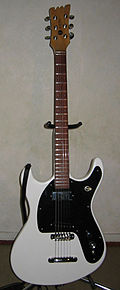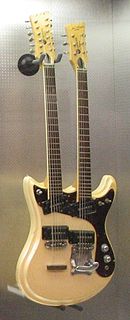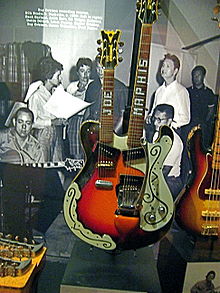- Mosrite
-
Mosrite is an American guitar manufacturing company, based in Bakersfield, California, from the late 1950s to the early 1990s. Founded by Semie Moseley, Mosrite guitars were played by many rock and roll and country artists.
Mosrite guitars were known for innovative design, high quality engineering, very thin, low-fretted and narrow necks, and extremely hot (high output) pickups. Moseley's design for The Ventures, known as the "Ventures Model" (later known as the "Mark I"), was generally considered to be the flagship of the line.
Contents
History
Apprenticeship
In Bakersfield, Semie Moseley started playing guitar in an evangelical group at age 13.[1] Semie and his brother Andy experimented with guitars from their teen-age years, refinishing instruments and building new necks.[2]
Semie Moseley began building guitars in the Los Angeles area around 1952 or 1953. He began by apprenticing at the Rickenbacker factory, where he learned much of his guitar making skills from Roger Rossmeisl, a German immigrant who brought old-world luthier techniques into the modern electric guitar manufacturing process. One of the most recognizable features on most Mosrite guitars is the "German Carve" on the top that Moseley learned from Rossmeisl. During the same time, Moseley apprenticed with Paul Bigsby in Downey, California, the man who made the first modern solid-body guitar for Merle Travis in 1948, and who invented the Bigsby vibrato tailpiece, which is still used today.
Mosrite founded
In 1954 Semie built a triple-neck guitar in his garage (the longest neck was a standard guitar, the second-longest neck an octave higher, the shortest was an eight-string mandolin). He presented a double-neck to Joe Maphis, a Los Angeles-area TV performer. By 1956, with an investment from Ray Boatwright, a local Los Angeles minister, Semie and Andy started their company, Mosrite of California. In gratitude to Boatwright, Moseley named the company by combining his and Boatwright's last names; the name is properly pronounced MOZE-rite, based on the pronunciation Semie Moseley used for his own name.[3] Semie, who built guitars for the L.A.-based Rickenbacker company, said to his co-workers that he was making his own product, and he was fired by Rickenbacker.[2]
When they began, their production was all custom, handmade guitars, built in garages, tin storage sheds, wherever the Moseleys could put equipment.[2]
In 1959, Andy moved to Nashville, Tennessee, for a year to popularize the Mosrite name and sold a few, including to Grand Ole Opry entertainers and road musicians. Andy said: "And that’s how we kept the factory going at the time: custom guitars".[2]
Moseley made guitars in Los Angeles until 1959, when he moved to Oildale, California, just north of Bakersfield.
In 1962 he moved his shop to Panama Lane where he designed and produced the first Joe Maphis model guitars, one model of which would eventually evolve into the "Ventures model" guitar and bass. (Joe Maphis would later get a model of his own, similar to a Mosrite Combo model but without the F-hole.) At this time, Mosrite made everything in-house, except for the tuners.[4] At the peak of production, in 1968, Mosrite was making around 1,000 guitars per month.[3]
Bankruptcy, and restart
Mosrite of California went bankrupt in late 1968 after they contracted with a competitor to market their guitars. After this, they tried to deal directly with stores, and they sold 280 guitars in 1969 before they came to the shop one day and found their doors pad-locked.[2] Two years after his bankruptcy, Semie was able to get back the Mosrite name, and in 1970 he started making guitars again in Pumpkin Center near Bakersfield. He moved his factory three times in the next 20 years, to Oklahoma City in the mid-70s, to the township of Jonas Ridge, in Burke County, North Carolina, in 1981 (where a factory fire destroyed the operation), and to Booneville, Arkansas, in 1991.[2]
Though an acknowledged genius at guitar design and construction, Moseley lacked many basic skills necessary to be a good businessman, and thus the company fell on hard times repeatedly in the late 1960s and 1970s, but continued to produce Mosrite guitars until 1993 in North Carolina and Arkansas. Most of them were exported to Japan, where their popularity remained very strong. The quality of the instruments always remained very respectable. Semie Moseley died in 1992. His wife Loretta continued to produce Mosrites a year or so after his death, and since 2008 has been selling custom Mosrites via their website.
The company now has recently[when?] released the Semie Moseley Model ’63 and ’65, based on the Ventures models made in those two years. Both models are made to the exact specifications as the original models; they are 100% hand-made and were created to commemorate Semie Moseley.
Semie's daughter, Dana Moseley, is also a luthier and continues to build Mosrite guitars.[5] She also helps kick off the monthly "Mosrite Jam" in Bakersfield.[6]
Guitar design
Vibramute Vibrato
Moseley designed his own hand vibrato units. The Vibramute consisted of a solid cast metal base, and a string stop connected to a vibrato arm lifted by a large spring. The bridge, also designed by Moseley, he called the RollerMatic bridge. Each string sat atop a raised post with individual string rollers. This allows for the tension between the string stop and bridge to stay equal to the tension between the bridge and nut, which helps the guitar stay in tune and reduces string wear when using the tremolo. It is also ideally positioned for easy palm muting of the strings. Early models of the Vibramute also had, as its name implies, a foam rubber string mute at the front, similar to the Fender Jaguar, but most players disliked it. That, in conjunction with many requests to lengthen the rather short vibrato handle, led Moseley to slightly re-design the unit for the 1965 and beyond guitars. He named this incarnation the "Moseley" vibrato, though its differences with the Vibramute are slight.
Body
The body of Mosrite Ventures models are shaped so that the lower horn of the body is longer than the upper. Many Mosrite Guitars have a beveled edge around the body called a "German carve".
The Gospel models were produced in various years and have experienced many and varied changes in the style of construction. While some of the later, solid-body Gospel guitars have a unique flat face body with rounded edges, the first prototypes, created in the mid-60s, were hollow, and based loosely on the Celebrity model. Notable differences include the mildly scalloped headstock that had the "Gospel" trademark and sign of the Cross, but not the Mosrite name. Hardware was solid brass, hand polished and chromed. Only two of the original Gospel prototypes survived the manufacturing process, as they were handcrafted by Semie, himself, using violin joints, rather than the serrated form blocks used to join most hollow body guitar sides to the top and back. The original Gospel guitars both had arched backs, as well as tops, with bound "F" holes. The transparent Blue Gospel, numbered GA009, was Semie's own personal guitar, used by him when playing on Gospel music tours. The all blonde Gospel was given to Semie's founding partner, the Reverend Ray Boatright. The Reverend was attacked in front of his church in Watts, he was killed, and the guitar was smashed. Thus, the only surviving original mid 60s "GA" prototype is Semie's Blue Gospel Guitar.
After the death of Reverend Boatright, Semie continued to play on Gospel Music Tours and also to develop more styles of Gospel Guitars, never quite matching the original prototypes. In the 1970s, he modified some Celebrity models and made Gospel guitars out of them. Semie always had the philosophy that Gospel musicians were doing the Lord's work and should have the very best instruments possible, even if they couldn't afford to pay very much. Throughout the years, Semie Moseley, and the Mostire Guitar Company, made many versions and models of Gospel guitars. They were never made consistently, in production runs, often changed from week to week, and were never manufactured in large numbers. Still, the original "GA" series prototype was said to sound so beautifully bell-like as to "Sing To The Angels".
Stereo 350 models are shaped similar to Fender's Telecaster guitar. Stereo 350 models feature two output jacks and a circuit to send each pickup's signal to a different amp, If desired.
Bluesbender and Brass Rail guitars are shaped similar to Gibson's Les Paul.
Neck
Models from the 60s have narrow and thin necks. Most also have thin, very low frets known as Speed Frets (.070 wide, .022 high or .022 on the bass side tapering to .015 on the treble side) Somewhat similar to Gibson "Fretless Wonders". However, Unlike a Fretless Wonder, Speed Frets are slightly rounded rather than flat. Mosrite guitars also had zero frets which allow for very low action. The headstock has the outline of the letter "M" at the top.
70s models generally have larger necks than the 1960s models.
Brass Rail models from the mid 70s feature a brass rail in the guitar neck that has the frets hammered in, in an attempt to create more sustain.
Notable users
- Joe Maphis[4]
- The Ventures
- Johnny Ramone[4]
- Art Greenhaw
- Iron Butterfly--Danny Weis and Erik Brann (guitar); Jerry Penrod and Lee Dorman (bass)
- Ricky Wilson of The B-52's
- Fred "Sonic" Smith of MC5
- Kurt Cobain of Nirvana
- Andrew Scott of Sloan
- Yuzo Kayama
- Takeshi Terauchi
- Dave Alexander of The Stooges
- Ben Weasel of the Riverdales
References
- ^ Thompson, Art, "Mosrite 40th Anniversary", Guitar Player magazine, January 2007.
- ^ a b c d e f Price, Robert, "The Man Behind the Mosrite" (archived 2008 copy), The Bakersfield Californian. Has biographical notes on Semie Moseley.
- ^ a b Roberts, James H. (2003). American basses: an illustrated history & player's guide. Hal Leonard. p. 128. ISBN 9780879307219. http://books.google.com/books?id=5lBKzcs746oC&pg=PA128.
- ^ a b c Hunter, Dave (2006). The Electric Guitar Sourcebook: How to Find the Sounds You Like. Hal Leonard. pp. 67–68. ISBN 9780879308865. http://books.google.com/books?id=u8qxXFvsqeMC&pg=PT68.
- ^ Dana Moseley page - Ed Roman Guitars
- ^ Munoz, Matt, "Mos-rite-teous! Lovers of Bakersfield guitar ready to jam", Bakotopia.com, Wednesday, Feb 17 2010
Further reading
- Landers, Rick; Brennan, Tim, "The Story of Mosrite Guitars, Part One". Modern Guitars magazine, January 18, 2005
- Price, Robert, "The Man Behind the Mosrite" (archived 2008 copy), The Bakersfield Californian. Has biographical notes on Semie Moseley.
External links
- mosrite.us
- Mosriteguitars.com
- The Mosrite Gospel guitar, North American Instruments, 2000. With some personal notes on its builder.
- "Mosrite History", Tym Guitars, Australia.
- Mosrite Guitars, "Mosrite Guitars at Front Porch Music", California
Categories:- Guitar manufacturing companies
Wikimedia Foundation. 2010.




